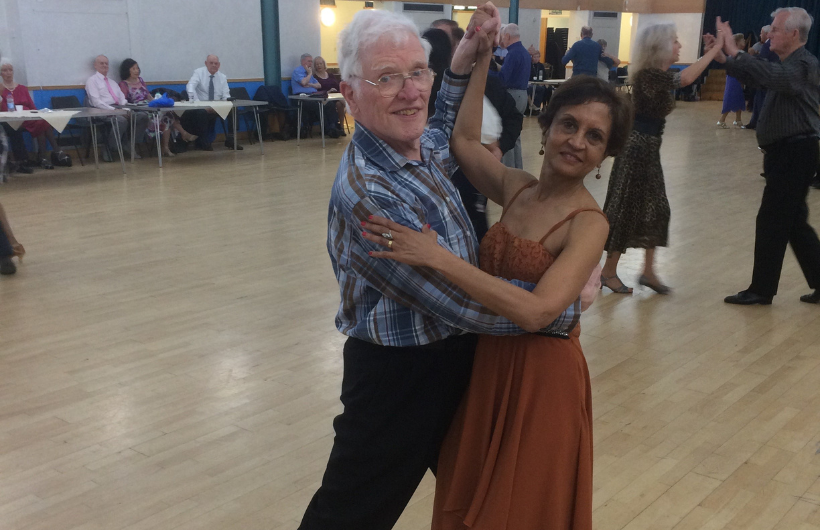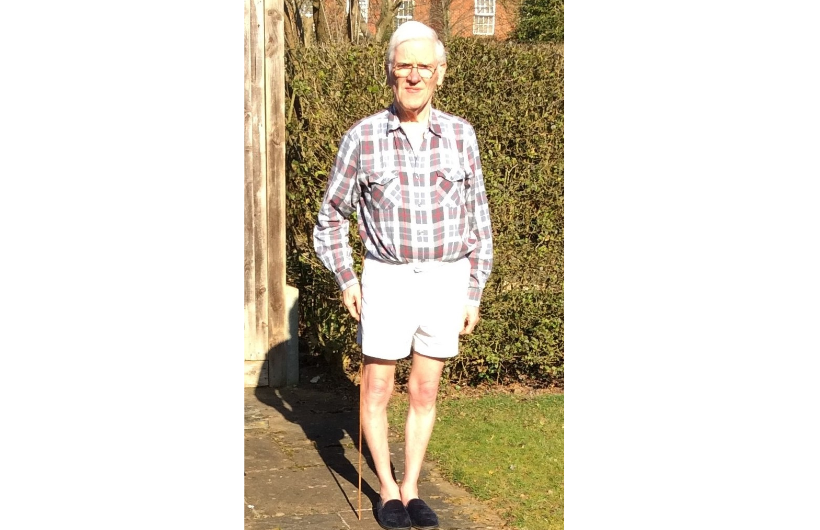Allan’s dancing again
Member, Allan from Hertfordshire, explains how he was diagnosed with Paget’s disease and how he had to stop dancing.

I am a Retired Chartered Mechanical Engineer and was aged 73 when Paget’s disease was diagnosed. I am divorced, live on my own, and among other interests, I am a keen Ballroom, Latin American, and Argentine Tango dancer. In the four weeks before my leg became a problem, I went to 23 dances. In September 2014 I went to my regular Friday afternoon tea dance. I remember that, during the afternoon, I danced a ‘Ballroom Tango’ for which the music was particularly vibrant, and I remember dancing it with much vigour.
The following day, I had pain in my right leg. I contacted the out of hours GP service and saw their doctor at the local hospital. My leg was swollen, painful, and I had difficulty walking. The doctor diagnosed cellulitis and prescribed steroid cream plus a course of antibiotics.
Various GP appointments followed, and at the end of October, a further prescription was given for another course of antibiotics. At one of the appointments, the GP commented that I had ‘bandy’ legs. If the GP had put two and two together, no mention was made to me that this might be Paget’s disease.
At my next appointment, at the beginning of November, I was referred for an x-ray of the tibia and fibula. It was from this x-ray that the GP advised me that I had Paget’s disease in my leg. He wrote ‘Paget’s’ on a piece of paper and said that I could ‘Google’ it and find further information. He referred me to an endocrinologist.
Having received the diagnosis, I sent the following email to 20 of my dancing friends:
‘If you were not already aware, unfortunately for the last 7 weeks, I have been unable to go dancing due to a problem with my right lower leg. This started as a lump, swelling, and pain when using the leg. The initial diagnosis was of cellulitis, which was treated with steroid cream and two sessions of antibiotics. This reduced the swelling revealing that the lump appeared to be fixed to the bone (tibia). The pain/discomfort continued. Last week I had an X-ray of the leg and an abnormality was found. I saw my doctor on Friday for the results and the diagnosis is now that I have Paget’s disease in the leg. I have now been referred to an endocrinologist and am waiting impatiently for that appointment. In the meanwhile - limited walking, and no dancing.’
You can see from the photograph how my leg has been visibly affected by Paget’s disease.

Shortly after this, I made contact with the Paget’s Association. Whilst I received an appointment letter on the 26 November 2014, the appointment, within the rheumatology department, was not until the 12th January 2015.
The following is an extract of the consultant rheumatologist’s letter to the referring GP:
‘… Four months ago, he developed pain and swelling affecting his right shin, which was thought to be due to cellulitis and treated, rather unsuccessfully, with antibiotics. A subsequent x-ray of the tibia and fibula has showed Paget’s disease involving the upper two-thirds of the tibia, with a translucent line through the anterior cortex representing a pseudofracture. The patient is a keen ballroom dancer and whilst he is now getting back to this activity, he still has some residual discomfort and swelling, although there is no overlying skin discolouration. He does think that his right leg has become more bowed, certainly it does appear to be the case when he stands erect. I have explained the nature of Paget’s disease to him although he has already been conducting his own research and is fairly well informed. As he is symptomatic I have recommended a course of risedronate 30 mg daily for two months.’
On the 21st January 2015, my alkaline phosphatase (ALP) level was 261. A blood test on the 3rd April, following a 2-month course of 30mg of risedronate tablets, showed that the ALP had been reduced to 135.
A few weeks later, I saw my GP again as I had reddening and heat coming from the tibia. I was given further risedronate at a lower dose of 5mg. Then a consultant appointment, in June, led to a further 8 weeks of 30 mg risedronate. My ALP level had reduced to 98.
On 21 July 2015, after attending a tea dance, I was walking and suddenly my right leg gave way. I was unable to put any weight on it. After contacting the 111 service, I was taken to the Accident and Emergency department at the Lister hospital in Stevenage. X-rays were taken and they confirmed that fortunately there was no fracture. I was advised that I had soft tissue damage and was given two elbow crutches to aid mobility. The pain and discomfort were in the same area as the Paget’s pain and discomfort. I was shown the x-rays, together with the x-ray taken in November 2014, where I could see the pseudofracture (not a true fracture); this appeared to be healing in the latest X-ray.
In September of 2015, I attended the Paget’s Information Day and Annual General Meeting, in Peterborough and the following year, the one in Norwich. These meetings gave me a much better understanding of Paget’s disease. After the first meeting, I was so appreciative that I became a life member of the Paget’s Association. At the meetings, I took the opportunely to discuss my Paget’s history with some of the lead people present as I had taken with me some of my Paget’s medical history. The following month the consultant informed me that my Paget’s disease was in remission. My ALP was 78.
I continued to have my ALP monitored and whilst it has risen a little, I have so far not required further treatment.
I was pleased to be able to support the Paget’s Association in January this year, when they contacted me, looking for someone in my area to give an interview for the local newspaper, the Welwyn Hatfield Times. They published the article, which featured my Paget’s disease and promoted the first Paget’s Awareness Day. I followed this up by attending the Paget’s Awareness Day at the James Paget Hospital in Great Yarmouth.
The pseudo fracture in the affected leg did impact on my social life and seriously curtailed my dancing. Fortunately, things are now returning to normal with both.
Allan
In this video Allan explains his experience to Professor Stuart Ralston.

